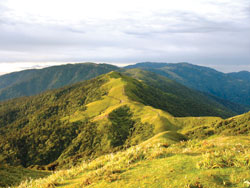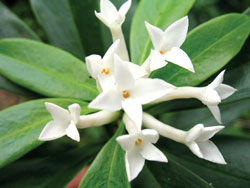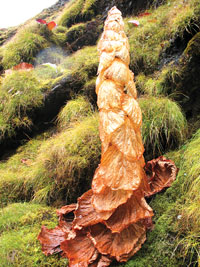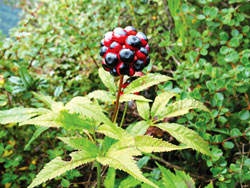|
|
It was the 38th day of the nearly two months that researchers from the Ethnobotanical Society of Nepal (ESON) had spent in the remote areas of Ilam and Panchthar.
They were surveying plants in the lush foothills of the Kangchenjunga range, and had been working non-stop for five hours that day starting at 8AM.
Since a visit to the sacred pond at Timbu Pokhari was planned for the day, the devout surveyors were fasting. From their night's camp in Ghumne (4,100m), the pond was a couple of hours' walk away. A light rain was falling and the temperature had plummeted to 5?C.
|
|
They prayed at the pond and when returning switched to an alternative track leading to a fairly remote terrain of over 4,300m. "It was there that we saw, standing a metre high with its flower bracts already a dried bright orange, the Rheum nobile", recalls K K Shrestha, describing the moment when the team first saw the endangered plant species.
For Shrestha, a veteran ethnobotanist, this was a joyous moment. He was seeing a plant, locally called kenjo, in the wild for the first time in 25 years. Later on they saw a few more plants scattered around, but that first sighting was unforgettable.
Planning a plant survey expedition is no easy task. The area where ESON was working is remote and takes about a week to get to. Plant collection expeditions are organised in the monsoon when the flowers are in bloom, helping identification. But monsoons are a difficult time to travel, especially in the Kangchenjunga area which gets nearly 4,000mm of rain a year, most of it falling in three months.
The absence of motorable roads in this remote part of eastern Nepal on the border with Sikkim means that all equipment for the kitchen, collecting and drying plants and sleeping have to be carried on yaks or by porters. There are no trekkers here, and few settlements.
A typical day involves 4-5 hours of walking and each day examining up to eight quadrat plots of 100 square metres, explains Ripu Kunwar, a member of Shrestha's team.
Two separate teams worked each plot, one collecting plants and the other inventorying. Each evening the day's collection of plants has to be dried over coal in a stone hearth.
Shrestha remembers the last expedition which ended in disaster when the drying tent caught fire, with some of the specimens inside. The ESON team brought back 600 plant samples of about 300 species, of which half have been identified at the species level and a quarter at the family or genus level. The remaining plants are undergoing identification.
ESON received a one-year grant from the Critical Ecosystem Partnership Fund (CEPF), to identify plant diversity hotspots in eastern Nepal a project that is being implemented by Worldwide Fund or Nature - Nepal.
Inventorying is just the first step in the process to identify high plant biodiversity areas. Through their work, the team has found that the Jamuna and Phalaincha VDCs in Ilam and Panchthar districts are richest in biodiversity. ESON is looking into involving the local communities in plant conservation.
"Our work does not end with identifying and naming plants. We now have the huge task of talking to the local communities here about the importance of conserving plants and working with them on the issue," says Shrestha.
|
|
Although community forests have helped conservation, they only go up to 2,500m. Higher than that, the forests are considered no-man's land and are pastures for yaks and sheep. There are signs of overgrazing, encroachment on forests and wildlife poaching. The team sees the removal of the cattle shelters, the provision of sources of alternative fuel and the handing over of unmanaged land to communities as solutions to the problems of plant conservation in these fragile areas.
Sampreethi Aipanjiguly is a communications officer with the Critical Ecosystem Partnership Fund, Eastern Himalaya.








